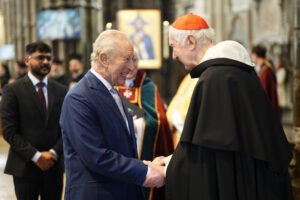Leaving Faith Behind: Patti Smith’s Journey from Jehovah’s Witnesses

Patti Smith
Introduction to Patti Smith and Her Background
Patti Smith, an influential figure in both the music and art scenes, is best known for her pioneering blend of rock music and poetry. Born on December 30, 1946, in Chicago, Illinois, Smith was raised in a household deeply rooted in the beliefs and practices of the Jehovah’s Witnesses. This upbringing played a significant role in shaping her early identity and worldview. The values instilled in her during her formative years often clashed with her artistic inclinations, leading to a gradual yet profound transformation in her belief system.
As the daughter of a jazz musician and a homemaker, Smith was exposed to a range of cultural influences from a young age. Her family dynamic, which was marked by a strict adherence to the tenets of Jehovah’s Witnesses, created an environment that both nurtured her artistic aspirations and imposed limitations on her expression. The expectations placed upon her by her faith often conflicted with her creative impulses, setting the stage for a pivotal shift in her life’s trajectory as she approached her teenage years.
The transition from her sheltered upbringing to the vibrant artistic communities of the 1960s and 1970s in New York City profoundly impacted Smith. It was within this milieu that she began to explore her identity outside the confines of her religious background. Encountering diverse artists, musicians, and poets provided Smith with new ways of thinking and being, challenging her previous beliefs and prompting her to reassess her relationship with Jehovah’s Witnesses. This period of exploration marked the beginning of her journey towards self-discovery, ultimately leading to her decision to leave the faith that had defined much of her early life.
Understanding Jehovah’s Witnesses
Jehovah’s Witnesses is a Christian denomination known for its distinct beliefs and practices, which greatly influence the lives of its adherents. Central to the faith is the belief in the sovereignty of Jehovah, the use of the Bible as the sole authority, and the idea of living life in a way that aligns with biblical teachings. Members are encouraged to cultivate a personal relationship with God, actively participating in community worship and outreach efforts. This emphasis on spirituality and community bonds can shape the formative years of individuals raised within this faith, such as Patti Smith.
The organizational structure of Jehovah’s Witnesses is marked by a hierarchical leadership known as the Governing Body, which interprets scripture and sets guidelines for the faith. This central authority plays a significant role in the lives of its members, dictating many aspects of daily life. Jehovah’s Witnesses are known for their strict adherence to moral conduct, avoiding behaviors deemed inconsistent with their beliefs, such as celebrating secular holidays or engaging in practices categorized as unwholesome by their interpretations of scripture.
The community aspect of Jehovah’s Witnesses is particularly prominent. Members often form tight-knit congregations, providing support and connections among families. This communal living instills a strong sense of identity and belonging, encouraging members to share their faith actively through door-to-door evangelism and other outreach programs. In an environment such as the one Patti Smith grew up in, the expectations of loyalty to the faith, combined with the surrounding social structure, could significantly shape one’s worldview and personal development.
Understanding these core beliefs and practices gives context to the upbringing of individuals like Patti Smith, illuminating the complexities of reconciling personal aspirations with communal responsibilities entrenched in strict religious teachings. Her journey from such a foundational experience speaks volumes about the challenges faced by those who grapple with faith, identity, and independence.
Patti’s Early Life and Religious Upbringing
Patti Smith was born on December 30, 1946, in Chicago, Illinois, to a modest family that adhered to the practices of Jehovah’s Witnesses. Growing up in the 1950s, Patti was immersed in a strict religious environment that profoundly shaped her early life. The doctrines of Jehovah’s Witnesses permeated her household, dictating everything from daily interactions to community involvement, reinforcing a distinct worldview centered around their faith. Family gatherings, discussions, and rituals included a focus on scriptural teachings and a commitment to spreading their beliefs, often leading to feelings of both comfort and confinement for young Patti.
The tenets of Jehovah’s Witnesses instilled in Patti a sense of discipline, as her upbringing was marked by regular attendance at meetings and assemblies, alongside door-to-door evangelizing. These practices contributed significantly to her moral framework but also conflicted with her evolving identity and artistic inclinations. Her family’s expectation to adhere to these faith-based practices was juxtaposed against her burgeoning curiosity about the world, art, and literature, which began to blossom during her teenage years.
A pivotal moment in her religious upbringing occurred when she experienced the tension between her family’s expectations and her personal beliefs. This struggle was magnified during her adolescence as she encountered new ideas and influences outside the rigid constraints of Jehovah’s Witnesses. This exposure ignited a questioning spirit within Patti, prompting her to reassess her faith and the role it played in her identity. Ultimately, her upbringing in a religious household served as both a guiding force and a source of internal conflict, shaping her artistic persona and worldview as she ventured into adulthood.
The Decision to Leave the Faith
Patti Smith’s departure from the Jehovah’s Witness faith marks a significant turning point in her life, shaped by a confluence of personal beliefs and external influences. Growing up in a strict, religious environment, Smith was immersed in the teachings and expectations of the Jehovah’s Witness community. As she entered her teenage years, however, she began to grapple with her identity and the constraints of the faith. This period of introspection and questioning played a crucial role in her decision-making process.
A pivotal motivation for Smith’s departure was her yearning for individual expression and artistic freedom. The rigid doctrines of the Jehovah’s Witnesses often clashed with her burgeoning desire to explore her creativity through music and poetry. As she discovered the vibrant world outside her faith, she felt increasingly confined by the community’s rules and beliefs. This tension between her artistic aspirations and her commitments as a Jehovah’s Witness created an internal struggle, pushing her towards a critical decision.
Faced with the reality of leaving behind not only her faith but also her community and family, Smith encountered numerous challenges. The stigma of being shunned by her peers and family members weighed heavily on her. Moreover, the fear of spiritual consequences lingered. Nevertheless, her resolve gradually strengthened as she weighed the benefits of living authentically against the potential fallout from her choice. Ultimately, this decision became a crucial part of her personal narrative, allowing her to redefine her identity outside the restrictive parameters of her childhood religion.
Leaving the Jehovah’s Witness faith was undeniably a complex process for Patti Smith, one that required immense courage and a firm commitment to her newfound path. Her journey not only illustrates the personal battles that often accompany such a significant life choice but also highlights the profound impact that faith can have on an individual’s sense of self and their relationships with loved ones.
The Emotional and Social Ramifications of Leaving
Patti Smith’s departure from the Jehovah’s Witnesses marked a significant turning point in her life, resulting in profound emotional and social consequences. Leaving a faith that has shaped her upbringing meant stepping away from a carefully constructed community that provided a sense of belonging and support. The emotional turmoil stemming from this decision cannot be underestimated, as it often leads to feelings of isolation and guilt, particularly when one’s family remains committed to the beliefs that are no longer part of her identity.
The religious community surrounding Jehovah’s Witnesses is tightly knit, and members often experience strong familial bonds reinforced by shared beliefs and practices. In Patti’s case, her choice to leave the religion likely created a rift between her and her family. Many adherents of Jehovah’s Witnesses may perceive leaving the faith as a rejection, which can lead to strained relationships and diminished support from loved ones. Such disconnections can exacerbate feelings of rejection and loneliness, further complicating the emotional landscape that Smith navigated after her departure.
In addition to familial impacts, the broader social ramifications also play a critical role. Friends who were once part of her close circle might have distanced themselves due to her decision, reflecting the often rigid boundaries that can be found within religious communities. The shift in social dynamics necessitated the need for Patti to forge new connections that aligned with her evolving beliefs, fostering a quest for authenticity that could be fraught with challenges.
Ultimately, the journey away from Jehovah’s Witnesses forced Smith to confront the complexities of individuality versus communal loyalty. This struggle not only shaped her personal narrative but also informed her artistic expression, as the quest for belonging—amidst the pain of leaving—remains a pervasive theme in her work.
Maintaining Family Bonds Despite Differences
Patti Smith’s journey away from the teachings of Jehovah’s Witnesses is a profound exploration of faith and personal identity, but it is also a testament to the resilience of familial relationships. One of the most significant aspects of her life has been her enduring bond with her sister, who remains committed to the beliefs and practices of their childhood faith. This juxtaposition between differing beliefs has not only highlighted the importance of love but also showcased the power of mutual respect in navigating complex family dynamics.
In their journey together, Patti and her sister have demonstrated that it is possible to cherish and uphold family ties regardless of divergent spiritual paths. Their relationship serves as an example of how two people can maintain a close connection while embracing their individual choices. Acknowledging their differences has allowed both parties to grow, fostering a deeper understanding of each other’s perspectives. For Patti, stepping away from the doctrines of Jehovah’s Witnesses did not equate to abandoning her family; rather, it set the stage for an alternative approach to constructive communication.
Their experiences illuminate a key principle: familial love transcends individual belief systems. When confronted with conversations about faith, they have chosen to approach these discussions with sensitivity and openness, recognizing that each person’s journey is informed by personal experiences. This respectful dialogue reinforces their bond, illustrating that love does not require unanimous agreement on faith but rather thrives in the acceptance of each person’s right to choose their path.
Ultimately, the relationship between Patti Smith and her sister is a powerful reminder that differences in belief do not diminish the connections nurtured by love and understanding. Their ability to maintain strong family ties amid contrasting faith experiences is a profound statement on the nature of love and respect within family structures.
Patti’s Artistic Expression and Departure from Religion
Patti Smith’s journey from her upbringing as a Jehovah’s Witness to a celebrated artist is marked by a significant transformation in her artistic expression. The doctrines and beliefs of her early life arguably provided a foundation that, upon her departure from organized religion, directly influenced her creative output in profound ways. As she distanced herself from the confines of her religious upbringing, themes of spiritual exploration and personal identity increasingly permeated her poetry and music.
The tension between her former faith and her emerging individuality can be observed in her lyrics and writings, where she often grapples with existential questions that resonate with both her secular experiences and her spiritual past. For instance, her ability to evoke raw emotion and a sense of yearning reflects a search for personal truth, illustrating the shift away from the communal beliefs of Jehovah’s Witnesses to a more introspective form of spirituality that celebrates personal experiences. The vivid imagery and poignant storytelling in her works often draw from her struggles, symbolizing both her break from tradition and her quest for authentic self-expression.
In her influential album “Horses,” released in 1975, Smith’s lyrics convey a richness that challenges conventional notions of faith and identity. The chaotic beauty of her music encapsulates her turbulent relationship with religion and art, allowing her to explore themes of love, loss, and the search for meaning beyond the constraints of institutional beliefs. Through her poetry, Smith articulates a longing for connection and understanding, which speaks to her evolving identity as both an artist and an individual. Thus, Patti Smith’s creative endeavors stand as a testament to her journey, exemplifying how her departure from religion has enriched her artistic voice and shaped her legacy.
The Broader Context of Leaving Organized Religion
Leaving organized religion, including groups like the Jehovah’s Witnesses, is not an isolated phenomenon but rather part of a larger trend observed across various belief systems. Many individuals have grappled with the complexities of faith transitions, often struggling with the emotional and psychological repercussions that accompany such significant life changes. The journey of leaving a structured faith can be marked by a mixture of liberation and loss, as individuals confront both the institutional aspects of their religion and the personal implications of their decisions.
Common experiences often include a period of doubt, reflection, and exploration of new beliefs or philosophies. For many people who leave organized religions, including those similar to the Jehovah’s Witnesses, a quest for personal truth takes precedence. As they disentangle their identities from previously held doctrines, they frequently encounter a range of societal perceptions. Family, friends, and communities may respond with confusion, concern, or even hostility, complicating the transition further. This could result in feelings of isolation as they navigate their new paths outside the confines of traditional religious frameworks.
Moreover, these journeys can foster a sense of camaraderie among those who have undergone similar transitions. Many individuals report finding communities, both online and offline, where shared experiences bring comfort and solidarity. Conversations in these circles often revolve around rebuilding one’s self-concept, redefining spirituality, and engaging in discussions about morality and ethics independent of religious influence.
Ultimately, the decision to leave organized religion, including groups like the Jehovah’s Witnesses, reflects a broader cultural shift toward individualism and the search for meaning in diverse forms. As more people seek authenticity and individual truth, the narratives emerging from these experiences can enrich the collective understanding of faith and identity in modern society.
Conclusion: Embracing Individuality and Relationships
Patti Smith’s journey from her upbringing as a Jehovah’s Witness to her emergence as a celebrated artist exemplifies the dynamic interplay between faith, individuality, and familial bonds. Throughout her life, Smith faced the challenging task of reconciling her deeply held beliefs with her desire for personal autonomy and artistic expression. This exploration emphasizes that individual choice is paramount, particularly in the face of rigid belief systems that often dictate one’s life path.
The significance of maintaining relationships, even with differing beliefs, is a vital theme in Smith’s narrative. While leaving the doctrines of Jehovah’s Witnesses may have created a rift, it also opened the door for authentic connections built on mutual respect and love. Patti’s experiences highlight that one’s journey does not require the severing of ties; rather, it offers an avenue for rich dialogue and understanding. Embracing individuality can lead to more profound relationships, as it encourages the acceptance of diverse perspectives.
Moreover, Patti Smith’s evolution reflects broader themes found in the journeys of many who wrestle with faith and identity. Such transformations remind us that liberation from dogma can enrich personal growth. In this sense, Smith’s narrative resonates not only with those who have similarly departed from organized religion but also with anyone who strives to carve out their unique path while cherishing family ties.
Ultimately, the complexities surrounding faith, individuality, and relationships reveal that it is possible to honor one’s heritage while pursuing personal truth. Patti Smith serves as a powerful testament to this balance, illustrating that the pursuit of authenticity can coexist harmoniously with the relationships we value. Through her life and work, she inspires others to embrace their journey of self-discovery and connection.













Leave a Reply
You must be logged in to post a comment.